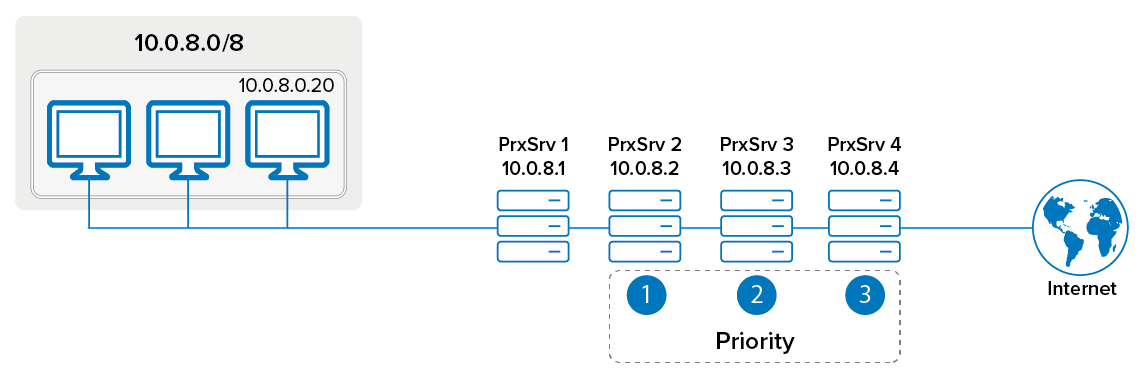For the HTTP Proxy service, you can configure the proxy server to treat adjacent proxies as parents or siblings. For the neighbor proxies, you can configure authentication and caching.
Configure a Neighbor Proxy
Go to CONFIGURATION > Configuration Tree > Box > Assigned Services > HTTP Proxy > HTTP Proxy Settings.
In the left menu, select IP Configuration.
Click Lock.
In the Neighbor Settings table, click + to add an entry for the neighboring proxy.
Enter a Name for the proxy and click OK.
NOTE: Because you can use this name in the ACL for the proxy server, do not use it when naming an entry in the How to Configure User Authentication and Access Control table!
In the Neighbor Settings window, configure the settings for the neighbor. For more details about these settings, see Neighbor Settings.
Click OK.
Click Send Changes and Activate.
Multiple Adjacent Proxies
If the proxy server will be surrounded by multiple adjacent neighbor caches, it is important that you correctly configure the caching settings for the neighbors. In particular, the Cache Priority setting directly affects the execution of the Cache Peer Access and Domain Restrictions settings (for more details about these settings, see Neighbor Settings). For example, consider the following scenario:
ProxySrv1 is surrounded by three neighbor caches.
ProxySrv2, ProxySrv3, and ProxySrv4 are configured as the parents of ProxySrv1.
The aim is to direct all requests with the source IP address of 10.0.8.20 to ProxySrv2. All requests with the destination of exampledomain.com should be directed to ProxySrv3. All other requests are to be fetched from the cache of ProxySrv4.

A Cache Peer Access filter must be set for ProxySrv2 and a Domain Restrictions filter must be set for ProxySrv3. ProxySrv4 is set up without any filters, which means that all requests that do not match the configured filters will be directed to it.
ProxySrv4 is vital for the example setup to work. If it is not present, requests that do not match the configured filters cannot be directed to any neighbor. ProxySrv1 cannot process the requests spontaneously without the appropriate directive.
The neighbor servers are configured with the following settings:
Server | Neighbor Settings |
|---|---|
ProxySrv2 |
|
ProxySrv3 |
|
ProxySrv4 |
|
Neighbor Settings
This table provides more detailed descriptions of the settings that you can configure for neighbor proxies:
Setting | Description |
|---|---|
Connection Type | The type of settings to use for the neighbor proxy. You can select one of the following types:
|
IP/Hostname | The hostname (FQDN) or IP address (IPv4 or IPv6) of the neighboring proxy server. |
Neighbor Type | The relationship to the neighboring proxy server. You can select:
|
Exclusive Parent | For a neighboring parent proxy server, select yes if it should handle all forwarding requests. This setting is recommended if the parent proxy is a virus scanning proxy server. |
Proxy Port | The port on which the neighbor server listens for incoming HTTP requests. By default, port |
ICP Port | The port on which the neighbor server listens for incoming ICP connections. By default, port 3130 is used. To configure a neighbor cache that does not use ICP, enable the UDP echo port on it and enter |
Cache Priority | The cache priority for the server. This setting is mandatory. Numbers with a lower value grant higher priority to the server. If only one neighbor cache exists, you can enter any value for the cache priority; the priority is ignored. |
Authentication | The authentication mechanism from the proxy to its neighbor. You can select:
|
Options | Additional options for the specified parent proxy. For example, you can enter options such as proxy-only, weight=n, ttl=n, no-query, default, round-robin, multicast-responder, closest-only, no-digest, no-netdb-exchange, connect-timeout=nn, digest-url=url, and allow-miss. For more information, see the Squid documentation. |
URL Fetching | If a page should be fetched directly from its origin server, add the complete URL or a list of words from the URL of the page. Before communicating with any of the cache peers, Squid tries fetching the requested URL directly from the server. If Squid cannot find the page, it tries to establish a connection to the configured parent caches. If you do not specify which protocol should be used to fetch the URL (for example, www.barracuda.com or *barracuda*), Squid tries to fetch the page via HTTP and FTP. If virus scanning and FTP scanning are activated for URLs that are fetched via FTP, you must specify the FTP protocol (for example, ftp://www.barracuda.com and ftp://*barracuda* ). Otherwise, the data stream is forwarded without virus scanning. It is recommended that you include dynamic pages in this tag (such as jsp, asp, and php). |
Cache Direct Objects | To cache URLs that are directly fetched with the URL Fetching settings, select yes. |
Domain | In this table, add the domains of the neighbor caches to be queried. Use the following syntax:
If a domain should be not queried from the cache, add a quotation mark ("!") before its name. For example:
Cache hosts that are configured without domain restrictions will be queried for all domains. |
Cache Domain | To cache URLs that are fetched with the Domain Restrictions setting, select yes. |
Cache Peer | In this table, add IP addresses and IP address ranges that must be directed to a specific neighbor cache. If restrictions are not configured, the cache will be queried for all requests. |
Cache IP | To cache requests originating from the IP addresses that are entered in the Cache Peer Access table, select yes. |
